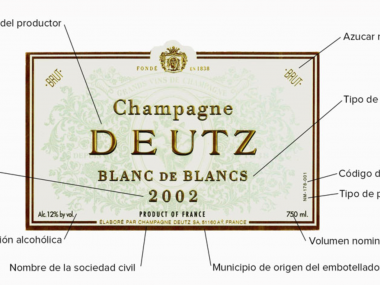It is not easy to choose the most suitable bottle of Champagne and, at the same time, it is a decision we do not want to make a mistake. First, because we usually buy it to celebrate special occasions. And second, because they are expensive.
Here you will find a simple guide with the different aspects that you should take into account to make an informed decision and choose the Champagne that best suits your palate.
The first thing to know is that not just any sparkling wine is a Champagne. Champagne refers specifically to the sparkling wine made in the Champagne region of France.
Amount of sugar
Brut Nature, Extra Brut, Brut, Dry, Semi-sec
The dosage (in French) or amount of sugar added to the Champagne after the second fermentation will determine how sweet or dry it is. We can distinguish in which part of the spectrum it is according to how it is catalogued:
Brut Nature: No sugar is added after disgorging. Its sugar content is less than 3 grams per liter.
Extra Brut: 0 to 6 grams of sugar per liter
Brut: Content less than 12 g/l in sugars.
Dry: Those containing between 17 and 32 g/l.
Semi-sec: Those containing between 32 and 50 g/l.
Vinification
Blanc de Blancs, Blanc de Noirs, Rosé
Champagne can be Blanc de Blancs, Blanc de Noirs or Rosé. Normally, there are three primary grapes used to make champagne, which are Chardonnay, Pinot Noir and Pinot Meunier. The way they are used or combined will indicate the style of the Champagne.
Blanc de Blancs
It is a white champagne made only from white grapes, which means that the wine is a 100% Chardonnay. These usually have more lemon and apple fruit flavors.
Blanc de Noirs
This is a white champagne made with 100% black grapes, which means that it involves a combination of only Pinot Noir and/or Pinot Meunier. Blanc de Noirs usually have more strawberry and white raspberry flavors.
Rosé
Rosé champagne is usually made by mixing white champagne with a little wine (10% or less) from Pinot Noir or Pinot Meunier. This red wine, however, is very different from the one consumed commercially, since its objective is to provide pure flavors of red and black fruits. They are rather sour, with low amount of tannins and high acidity.
Aging
One of the factors that influence the taste of champagne is the aging time. A vintage wine must have a minimum of three years of aging. Aging on lees will give it aromas of patisserie, toast and nuts.
On the other hand, a non-vintage champagne will have a minimum of 15 months of ageing. This will be much more fruity than the previous one.
Classification
Premier Cru, Grand Cru
The ratings of Premier Cru and Grand Cru are an indication that the vineyards have demonstrated an ability to produce exceptional wine grapes that make high quality champagne.
Type of producer
If you want to know who made the champagne before you buy it, it’s very easy to check the label. If you are interested in the big producers (Moët, Veuve Clicquot, Perrier, Bollinger, etc.), go for the Maisons (the big houses). If, on the other hand, you prefer to support small or medium-sized producers, then Vignerons and Cooperatives will be your thing.
Regional terroir
There are 5 main Champagne growing regions, and each of them has its distinctive qualities:
Rheims Mountain
Its sloping vineyards allow the wine grapes to reach optimum ripeness. The protagonist of this region is the Pinot Noir, from which you can expect fuller-bodied and richer-flavored champagne. The area contains 10 of the 17 Grand Cru vineyards, including Ambonnay, Bouzy, Verzy, Verzenay and Mailly-Champagne.
Vallée de la Marne
The valley along the Marne River has many slopes planted with vineyards. There is only one Grand Cru vineyard here, called Aÿ. The most used grape here is Pinot Meunier, which has an easier ripening time and produces a rich style of champagne with smoky flavors.
Côte des Blancs
It is mainly planted with Chardonnay and contains six areas of Grand Cru vineyards. This is the Blanc des Blancs area, which produces some of the best single-varietal champagne wines on the market.
Côte de Sézanne
South of the Côte des Blancs there is another slope that has many vineyards, with a similar dominance in Chardonnay.
Côte des Bar
This region is far from the rest, on the border between Champagne and Burgundy. It is planted mainly with Pinot Noir and produces a richer style of champagne, similar to that of the Montagne de Reims. Since it is a relatively new area in champagne making, it does not yet have any Grand Cru or Premier Cru vineyards.






